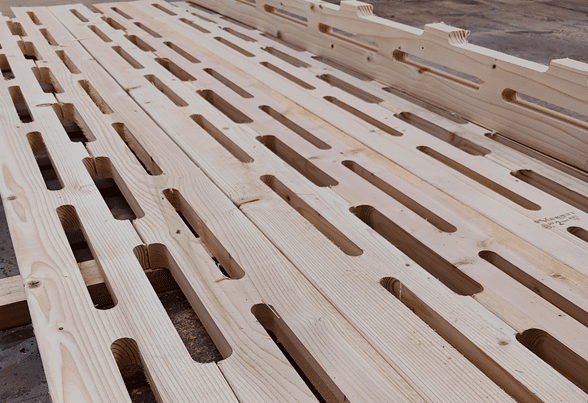Using EcoSmart™ Studs in Wood Framed Construction
The EcoSmart Stud TER 2304-120 is provided by DrJ Engineering. DrJ Engineering works alongside creative companies to bring new and existing products, processes, and services to the market professionally, reliably, and cost-effectively through generally accepted wall framing practices. Download the EcoSmart™ Stud TER in PDF format or a sealed TER with the link below for more details on exterior wall insulation and how to frame a wall using EcoSmart™ Studs.
How to use the EcoSmart Stud
™
General Installation instructions
-
How to Frame a Wall with EcoSmart™ Studs:
- Frame with 2×6 or 2×8 EcoSmart™ Studs just like standard wall framing for wood framed construction.
- Position spacers or nubs to face the exterior side installation with the building sheathing and optimal exterior wall insulation.
- The solid side of the stud goes to the interior side of the building.
-
Wall Framing Techniques:
- Frame 16” or 24“ on center. Observe other framing requirements when using at 24” on center advanced wall framing techniques.
- Standard solid top plate(s) and bottom plate.
- Alternate plate assemblies can be used for advanced framing.
- The ESS can be used as a cripple stud. If the slot in the ESS is split where it touches the upper or lower framing, a nail needs to be placed on each side of the slot.
- The ESS can be used for header support.
-
Nailing and Sheathing Guidelines:
- Nails for framing: Use 3″ or 3 1/2″ 0.131 box or better nails are used for assembling the framed wall.
- Nails for Sheathing: 2 3/8″, 2 1/2″ or 2 3/4″ 0.113 box nails or better for sheathing nails.
- Follow a standard nailing pattern of 6” on center on the perimeter and 12” on center in the field for non-high wind areas. In high-wind areas, follow local code nailing pattern(s) for secure wall framing.
- Alternate nailing pattern: 6″ on center for the top and bottom plates. On the vertical perimeter studs place 2 sheathing nails in each nub 1 3/4″ apart from each nail. Do this for each nub on the vertical perimeter studs. See this PDF for more details.
-
Spacer/Nubs and Perimeter Nails
- Spacers/nubs: 2×6 or 2×8 ESS are designed for direct contact between sheathing and the ESS for the 6/12 nailing pattern. For the field ESS stud install the nail in the spacer/nub.
- Spacer/Nubs: 2×6 or 2×8 ESS at the perimeter stud location for 6″ on center nailing, nails are installed into the spacer/nub and also installed half way between the spacer/nubs.
- Perimeter Nails: 2×6 or 2×8 ESS for 7/16″ or 1/2″ sheathing, 2 3/8″ sheathing nails can be used to get 1” of penetration needed into the ESS for building code.
- Perimeter Nails: 2×6 or 2×8 ESS for 5/8 or 3/4″ sheathing ,2 1/2″ sheathing nails are needed for 1” of penetration needed into the ESS for building code.
- Perimeter nails: The 2×6 ESS Aux stud, 2 3/8″ sheathing nails can be used to attach sheathing for up to 1 1/4″ sheathing.
-
Utility Pass-Throughs and Reinforcement:
- Gas lines, electrical, and low voltage wiring can pass through the slots without additional drilling.
- If for any reason an individual ESS will not work in the wall assembly, simply use a solid 2×6 or 2×8 in its place.
- Use plywood gussets to reinforce the ESS if damaged during installation or by trade installers.
-
2 lb Closed Cell Spray foam Installation instructions.
- Exterior Wall Insulation: Apply closed cell 2 lb. spray foam along the perimeter ESS studs, bottom plates, and top plates. The closed cell 2 lb. spray foam must fill the gap between the ESS perimeter, field studs, and the sheathing. This for structural reinforcement.
- Extend 2.0″ onto the vertical studs and 4″ onto connected sheathing and plates.
- The closed cell 2 lb. spray foam must extend 2.0″ onto the ESS perimeter vertical studs and 4″ onto the connected sheathing to the ESS studs and 4″ onto the plates and connected sheathing. A minimum depth of 1″ of closed cell 2 lb. spray foam must be added to the chamber to complete the structural reinforcement of the exterior wall.
- For hybrid installations of 2×6 or 2×8 ESS where a solid 2×6 or 2×8 stud or a 2×6 ESS Aux is used at the perimeter stud locations, no 2 lb. closed cell spray foam is needed for structural reinforcement.
- Closed cell 2 lb. spray foam (SPF) 1″ in depth in the chamber is the minimum depth required for standard 2×6 or 2×8 ESS standard or hybrid installations to meet 2021/2024 Energy Code R-22 effective insulation requirement for exterior walls. Check with your local AHJ for SPF depth required in the chamber in your area for Flash and Fill insulation requirements.
- Use a depth gauge to check for depth and adhesion of the closed cell 2 lb. spray foam.
- Best practice for SPF installation is to picture frame the chamber first, then fill the chamber area with SPF to the depth required by the local AHJ.
- Filling the slot(s) of the 2×6 or 2×8 ESS will add extra reinforcement to the wall assembly, but is not required.
Windows
Good Solution
- Use a solid 2×6 or 2×8 for the trimmer studs to support the header and top and bottom plates, simplifying installation.
- Use EcoSmart™ Studs (ESS) as King studs on both sides and as cripple studs under the window for wall framing.
Better Solution
- For 2×6 or 2×8 ESS, turn the ESS backwards so the spacers/nubs face the interior side of the wall.
- This positions the solid part of the stud to face the nailing flange of the window, providing a stable base for the bottom plate and the two trimmer studs supporting the header.
- King studs are positioned normally, with cripple studs under the window plate to maintain proper wall framing alignment.
Best Solution
- For 2×6 and 2×8 walls, use 2×6 or 2×8 ESS for the King studs.
- For trimmer studs and sill plates, use 2×6 or 2×8 Jack/Trimmer studs.
- Align all slots and nubs for accurate wall framing and to ensure proper insulation around the window.
- 2×8 ESS can be used for the cripple studs also. Make sure nubs are lined up properly aligned for the exterior sheathing.
How to Frame a Wall for Doors
Good Solution
- Use a solid stud for the trimmer studs to support the header, ensuring strong structural support.
- Use standard ESS for the King studs on both sides of the header to maintain consistent wall framing.
Better Solution
- For 2×6 and 2×8 walls, use ESS studs as usual for King and trimmer studs.
- If the door has a nailing flange, turn the ESS around so the solid part of the stud faces the nailing flange, providing a secure base for door installation.
Best Solution
- For 2×6 walls, use 2×6 ESS Jack/Trimmer studs and 2×6 ESS for King studs for enhanced structural stability and improved exterior wall insulation.
- For 2×8 walls, use a combination of 2×4 and 2×3 studs to create a complete thermal break.

All the Rest
Corners
For wall framing details on inside and outside Energy Corners, click this LINK to download the PDF or visit our resource section. EcoSmart™ Stud inside and outside Energy Corners are a mix of solid studs and ESS studs, designed for effective wood framed construction. A correctly framed corner is completely thermally broken, improving exterior wall insulation, and structurally reinforced by the installed 2 lb closed cell spray foam.
Plumbing
While plumbing should not be in exterior walls, if a drain line is needed that will cut through an ESS, place a solid 2×6 or 2×8 stud(s) instead. If a trade installer cuts a larger hole in an ESS during installation, plywood gussets can be attached to both sides of the stud for structural reinforcement. Most electrical, low voltage, water supply lines, and gas lines will fit through the provided slots, ensuring efficient wood framed construction.
Posts
ESS can be used for posts, they are treated just like a solid 2×4 stud. In certain situations, they may need to be glued together along with being nailed. Make sure to align the slots/nubs before gluing. Check with your local jurisdiction.
Multiple ESS together
When 2 or more ESS are together in the wall framing, they need to have the slots/nubs lined up so spray foam can be inserted during insulation. If one or more of the studs are not full length, match them up before installing them in the wall to ensure all slots and nubs align for insulation.
- This is especially important around windows to maintain consistent wall framing.
- It is important the slots/nubs are lined up for nailing sheathing onto the ESS.
- There is no designated top or bottom to the ESS. Cut shorter studs from each end first, using the middle part for other purposes if needed, ensuring efficient use of materials.
HOW TO ORDER
Contact us today to learn more about EcoSmart Stud and how it can benefit your next construction project. EcoSmart Stud is now available nationwide.
Call us at +1-612-887-5200 or click below to fill out the contact form.
CONTACT PRIORITY LIST